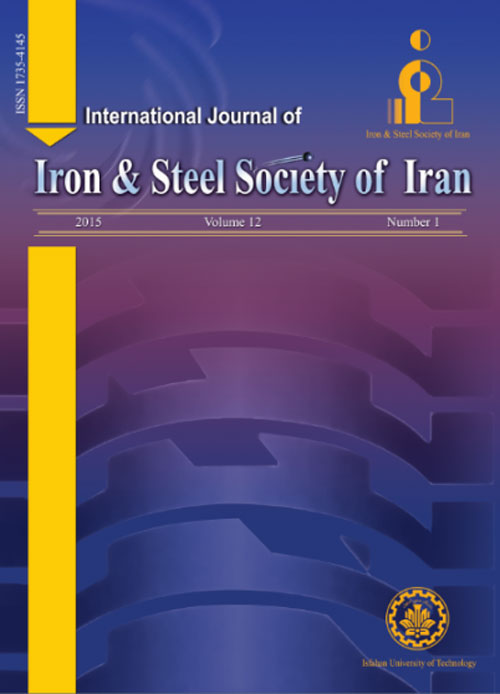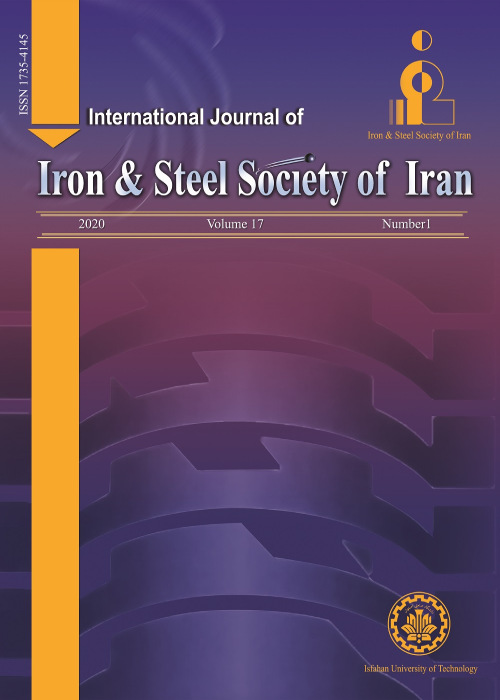فهرست مطالب

International Journal of iron and steel society of Iran
Volume:14 Issue: 1, Summer and Autumn 2017
- تاریخ انتشار: 1396/05/23
- تعداد عناوین: 7
-
-
Pages 1-9In this paper, a 0.2 C1.6 Mn1.5 Si wt. % TRIP-aided cold-rolled steel sheet was fabricated and the optimal heat treatment conditions (Intercritical Annealing IA and Bainitic Isothermal Transformation BIT) were investigated to maximize the volume fraction and stability of the retained austenite. The effects of temperature on IA (770, 790 and 810 ºC) and BIT (330, 350 and 370 ºC) were studied via optical microscopy, SEM and XRD. Its tensile properties and formability were also evaluated. It is obtained that under conditions of 790 ºC /330 ºC and 770 ºC /350 ºC, the maximum and minimum amounts of the retained austenite resulted in a microstructure. Also, for the case which heat treated under 790 ºC /330 ºC condition obtained the best formability by showing the highest elongation ( more than 40%) and the case that heat treated under 810 ºC /350 ºC condition had the highest tensile strength (more than 800 MPa). The cases with the maximum (12.1 %) and minimum (8.1 %) volume fraction of the retained austenite were chosen to investigate the effect of initial microstructure on weldability of TRIP steels. Therefore these cases were joined by friction stir spot welding process under the same welding parameters. According to the microstructural observations, four different zones determined in the welding region: stir zone, thermomechanically affected zone and high and low temperature heat affected zones.
It is obtained that the steel with higher amount of the retained austenite in initial microstructure shows better mechanical properties before and after FSSW process because of higher amount of the retained austenite which causes TRIP effect.Keywords: TRIP steel, Friction stir spot welding, Heat treatment, Retained austenite, microstructure -
Pages 10-16Resistance spot welding (RSW) includes many variables that can influence the weld properties. The purpose of this study is to develop an analytical model for prediction of thermal history and weld microstructure in RSW and to find the most important process parameters that influence the weld microstructure. A one dimensional model is proposed for prediction about thermal history during cooling step of RSW process. The reliability of analytical model is evaluated by experiments and numerical simulations. The calculations reveal that the current analytical model is reliable particularly at the temperatures lower than Tm/2. Sheet surface temperature at electrode-sheet interface and sheet thickness are recognized as the most important factors affecting the cooling rate at TKeywords: Resistance welding, Simulation, modeling, Weld microstructure, Cooling rate
-
Pages 17-22Using wastes as starting raw materials is a common method to reduce the production costs and the environmental pollution problems arising from such wastes. In this study the production and crystallization behavior of an iron rich glass prepared by iron and steel making wastes has been investigated. The raw materials used, were the blast furnace slag, the blast furnace dust, converter slag and sludge, and agglomeration sludge. The glass was prepared by melting the proper amounts of raw materials at 1400 ˚C and devitrification of the glass followed by appropriate heat treatment at 850 ˚C. The as cast glass was characterized by differential thermal analysis, X-ray diffraction to assess the structural evolutions and scanning electron microscopy. The results showed that after the crystallization of the base glass at 850 ˚C, the major crystalline phase was Diopside and it nucleated heterogeneously on colloidal iron particles which were present in the base glass. In fact, the ceramic phases surrounded the metallic iron particles confirmed that these metallic particles could be suitable heterogeneous sites for nucleation of crystalline phases.Keywords: Glass-Ceramics, Crystallization, Iron, steel making wastes
-
Pages 23-29Formation of nano/ultrafine grain structure in AISI 304L austenitic stainless steel through the martensite reversion treatment was studied. The solution annealed specimens were cold rolled up to 95 % thickness reduction at -15°C. The cold-rolled specimens were subjected to reversion annealing treatment at the temperature range of 700-1000 °C for 10150 min. Microstructural evolutions were analyzed using ferritscopy, X-ray diffraction, and field emission scanning electron microscopy techniques, whereas mechanical properties were determined by hardness test. The saturation strain during cold rolling was about 56 % reduction. The mean austenite grain size of 135 nm was obtained by 95 % cold reduction and annealing at 700 °C for 10 min. It was found that increasing cold reduction resulted in grain refinement at the same condition of reversion annealing and higher hardness.Keywords: Nano-ultrafine, Stainless steel, Cold work, Reversion annealing
-
Pages 30-37Steel consumption is a critical factor affecting pricing decisions and a key element to achieve sustainable industrial development. Forecasting future trends of steel consumption based on analysis of nonlinear patterns using artificial intelligence (AI) techniques is the main purpose of this paper. Because there are several features affecting target variable which make the analysis of relationships between variables difficult, so it is needed forintelligence tools in order to recognize the nonlinear patterns and select the most effective features as final input variables. Generally, in the real world problems, a nonlinear pattern recognition and feature clustering usually involve high-dimensional features that make the clustering problem complex. In fact without feature subset selection and dimensionality reduction, both training accuracy and generalization capability of forecasting models will be significantly reduced. In this paper, artificial neural networks are applied in order to profit from unique advantages of both forecasting and clustering power of the artificial neural networks to create an efficient and accurate model in high-dimensional situations. This way, at first, self-organizing map (SOM) is applied as an unsupervised clustering technique to detect nonlinear patterns between explanatory variables and to determine final effective input variables. Then the best multilayer perceptron is designed by these variables in order to forecast future trends of steel consumption. The empirical results of Iran's steel consumption forecasting confirm that the proposed model exhibits effectively improved forecasting accuracy in comparison to traditional feature selection methods such as forward and backward.Keywords: Self-organizing maps (SOMs), Nonlinear Pattern recognition, Feature clustering, Dimensionality reduction, Artificial neural networks (ANNs), Steel consumption forecasting
-
Pages 38-43Nowadays, SiC is one of the refractory materials which is used widespread because of its unique properties like structural stability in high temperatures. SiC nano whiskers are important in reinforcement of different kinds of composites like ceramic base materials, thanks to their outstanding mechanical, thermal, and chemical properties like low expansion coefficient, high thermal resistant, high elastic coefficient, low density, and high resistant to oxidation. The most important problem of MgO-C refractories is carbon oxidation in high temperatures, resulting in the porosity and loss of strength. Using SiC as an antioxidant in such refractories also improves thebehavior of MgO-C refractories. In this study ferrosilicon has been used to prepare insitu nano SiC whiskers and the effects of insitu SiC nano-whiskers on mechanical, physical and corrosion properties of MgO-C refractories during heat treatment have been investigated. The strength was measured by Cold crushing strength (CCS) according to ASTM C133-97 and Brazilian test. Also, bulk density (BD) and apparent porosity (AP) were studied according to ASTM C-20-92. XRD and SEM have been used to study phase composition and observing the structure, respectively. The results showed that by the formation of these nano-whiskers at high temperatures the strength was increased and corrosion and physical properties have been improved.Keywords: MgO-C refractories, SiC nano-whiskers, Strength, Corrosion, Physical properties
-
Pages 44-49The aim of this study is to design the excellence in Mobarakeh Steel Company's strategic knowledge management. To achieve this goal, the researcher has used qualitative and quantitative methods. Therefore, the research method is the mixed one. This study, based on the nature of the data and data collection procedure, is a descriptive, exploratory research. It follows and applies development objective. Strategic Knowledge Management Excellence Model (SKMEM) is presented in three components (strategy, process and results), 13 criteria and 80 sub-criteria and with a score of 6170 as a suggested model for the excellence in Mobarakeh Steel Company, in this way while the organization is analysing the state of knowledge it can also improve its plans and actions and track the excellence. In addition the results of quantitative analysis showed that, Mobarakeh Steel Company has achieved 4478 points in the Strategic Knowledge Management Excellence Model.Keywords: Strategic knowledge management, excellence models, Fuzzy Delphi Technique, Mobarakeh Steel Company


